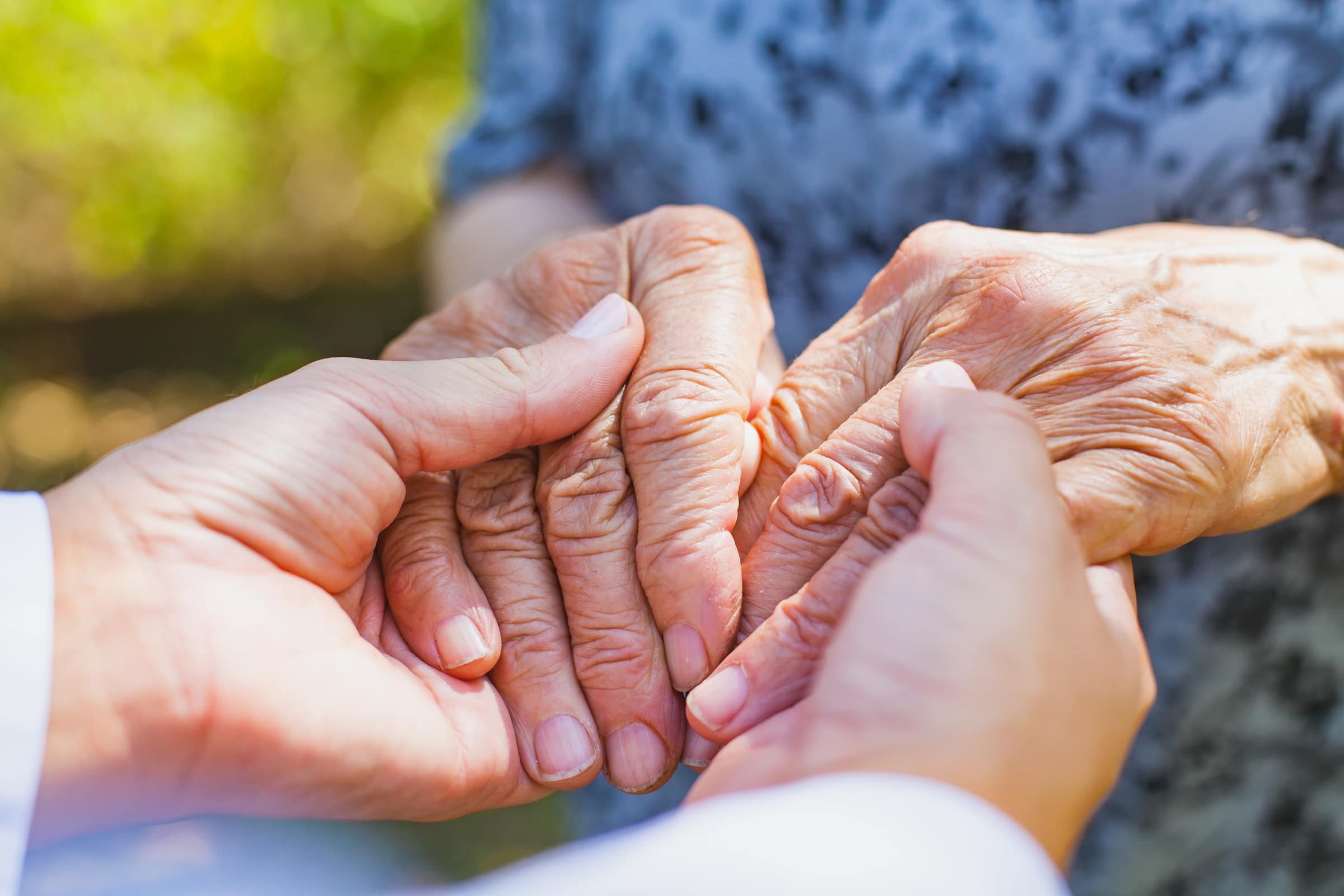A wide variety of complementary therapies have proven to be clinically beneficial to hospice patients—including decreasing their pain and increasing their feelings of well-being.
In a 2015 analysis of hospice care, it was found that art, massage and music therapies, coupled with traditional medicine, were helpful to both patients and their families. In addition to those, pet therapy has been found especially rewarding. These services focus on enrichment, beyond typical medical care, to augment other comfort measures.
SALMON VNA & Hospice, of SALMON Health and Retirement, provides three different complementary therapies in their hospice care, understanding the significant and positive role they can play.
1. Pet Therapy
What is it?
In formal terms, Pet Therapy is “a guided interaction between a person and a trained animal. It also involves the animal’s handler. The purpose of pet therapy is to help someone recover from or cope with a health problem or mental disorder.” SALMON Hospice recommends our pet therapy team (a handler accompanying a dog) for every patient we feel would find it a positive experience.
Why do it?
Therapy animals are not like assistance or emotional support animals. A therapy animal fulfills specific purposes: first and foremost, they benefit many individuals; they are safe to approach and pet in public places; and they are tolerant of a wide variety of environments.

Unlike typical house pets, therapy animals and their handlers have specialized training, making them ready to manage different situations; the animals have strict health clearances, are clean and free of parasites. SALMON’s team of handler and dog is re-registered with Pet Partners every two years; the team is also covered by insurance in case of incident.
In addition to the enthusiasm (and amusement) our dogs elicit from most people in most situations, they offer particular benefits to patients in hospice care. A visit from the pet team can often help patients by:
• Diminishing loneliness
• Lowering blood pressure
• Decreasing both anxiety and stress
• Elevating mood
• Improving emotional health
Even people who have previously been fearful of them are receptive to the charms of sweet, docile dogs.
How is it done?
The person may be in or out of bed, by themselves or in a group. Our handler will engage the patient with the therapy dog. Through the calm and gentle way the dog approaches and reacts to each person they meet, a warm bond is typically forged. And, with subsequent visits, their special connection is reinforced as the two get to know each other better. Handler, patient and dog find a new and satisfying relationship develops between them – and right away.
2. Massage Therapy
What is it?
In formal terms, Massage Therapy is “the manual manipulation of soft tissue of the body, including muscles, connective tissue, tendons, ligaments and joints, to enhance a person’s health and well-being.” While SALMON’s Hospice team recommends this service for numerous people they serve, a physician’s order is required for any hospice patient to receive massage therapy.
Why do it?
Many people of all ages and situations have enjoyed massages from licensed therapists. Some of us pursue it on a regular basis; others view it as a luxury – pure indulgence. Massage has many “fans,” but not everyone is drawn to it. However, patients in hospice – even people who have been uncomfortable with the idea in the past – can be attracted to (or willing to try) massage because, during end-of-life care, it frequently results in both ease of specific symptoms and overall serenity.
The variety of benefits massage regularly delivers to hospice patients is extensive and wide-ranging. It can include:
• Increased relaxation
• Reduced pain
• Greater comfort and feelings of tranquility
• Diminished muscle tension
• Improved sleep
• Lessening of anxiety
• Heightened release of endorphins and oxytocin, the “feel good” hormones
• Lowering of stress
• Elevated feelings of care and support
How is it done?
Our massage therapist visits patients wherever they are living. The person may be in bed, seated in any type of chair, lying on a sofa – the place they find most comfortable.
Unlike other, more rigorous techniques commonly practiced in massage, Hospice massage therapy is inherently gentle. The massage therapist is sensitive to each person’s needs and wishes, while keeping mindful of safety in all cases. Patients and family members can be confident the treatment received will always be appropriate.
Different approaches are available, such as: acupressure, with thumbs, fingers or palms applying gentle pressure to specific points on the body; or reiki, a technique based on channeling energy by means of touch for feelings of greater physical and emotional well-being. Aromatherapy, incorporating aromatic plant extracts and essential oils, may be used in combination with massage.
3. Music Therapy
What is it?
In formal terms, Music Therapy is “the clinical use of music interventions to accomplish individualized goals within a therapeutic relationship by a credentialed professional.” To put it more simply, it’s the use of music to provide health benefits by a board-certified clinician. SALMON Hospice provides this service for every patient our team feels would find it a positive experience.
Why do it?
While preferences in style vary, the human response to music seems nearly universally delightful; whether in the background or enjoyed front-and-
center, many people find music important, even essential. Live music, in particular, holds a strong attraction for most people.
Beyond pure enjoyment, music contributes to better health. Hospice patients often benefit from live music in specific ways, because it can:
• Help decrease anxiety
• Induce sleep
• Increase relaxation
• Provide a distraction from negative behaviors
• Lessen the awareness of pain
• Help maintain a sense of identity
• Tap into spiritual and existential concerns
• Bring familiar and pleasant feelings
• Reach those with Alzheimer’s disease and other forms of dementia
• Open an avenue of communication
How is it done?
Our music therapist visits patients wherever they are living and engages them through live music played with guitar, voice and/or piano. The person may be in or out of bed, by themselves or in a group. Individualized recordings can also be made. The approach can take several forms to fulfill different purposes.

Active singing and music making is therapeutic for many patients, including those with dementia who tap into remaining memories for what can be surprisingly robust renditions of favorite songs and hymns. A type of “life review through music” occurs for many patients, making especially meaningful moments between them and their family members. Soft music is also available, sung or played, to assist patients in pain reduction, encouraging sleep and fostering an atmosphere of safety, peace and support.
The therapist is happy to record a CD of a patient’s favorite music for them to enjoy between visits, they can also assist patients in writing and/or recording music to create a legacy project for their family.
Conclusion
Discussing massage, music and pet therapy with a hospice professional will help determine which would be most desirable for a specific patient and their family. In many cases, a combination of them—or all three—can deliver the greatest benefit.
Angela Rhoads, vice president of hospice operations at Interim HealthCare Inc. describes these different options as “’providing the experience of life for hospice patients and families that provides the competitive advantage.’
SALMON’s Hospice team strives to ensure patients and their families receive all the services possible to enhance the life of each individual in their care.




